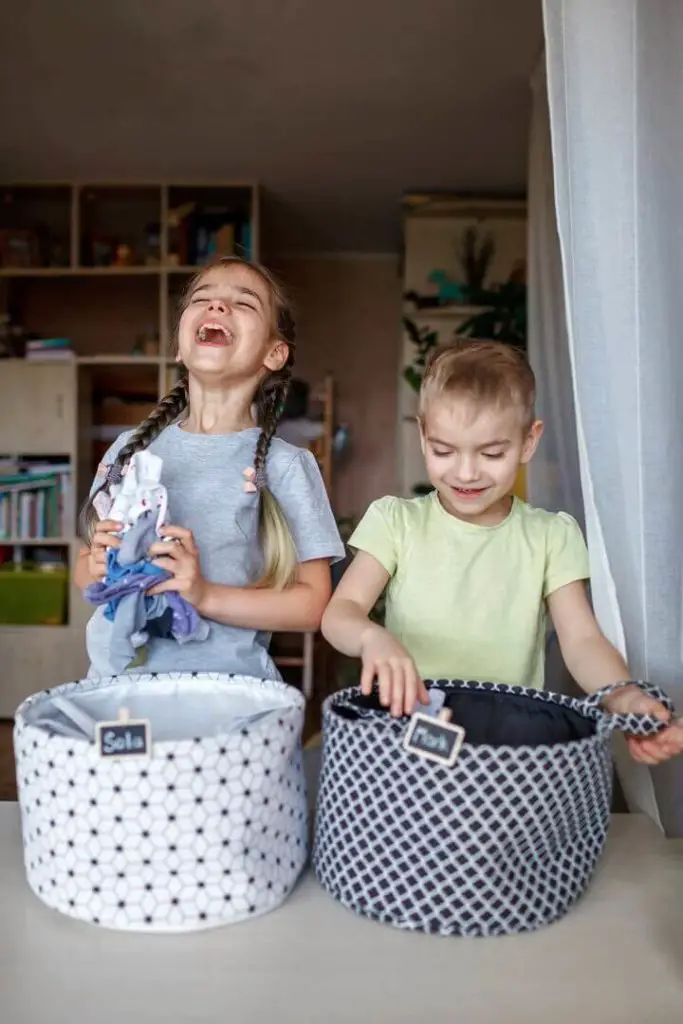Estimated reading time: 17 minutes
As parents, we all hope that one day our kids will be independent and confident in their adult lives. A skill to pass on in the process is helping them understand the value of self-sufficiency, and this can start as toddlers.
Kids who have learned self-sufficiency skills are confident in their abilities, and that gives them a sense of pride in what they can accomplish. It teaches them the joy of success in small tasks and the natural rewards in the large ones.
Want to save this post for later? Click Here to Pin It On Pinterest!
Tips for Parents
It’s easy to hope that a teen will suddenly take steps toward independence and adulthood, but if we have helicoptered them for too long, it’s on us for holding them back. Any helicopter parent is coming from a place of love, but to begin the journey of self-sufficiency, it’s an act of shifting that love to allow the personal growth for each kid.
Teaching self-sufficiency does not mean neglecting needs; it will require more intentional and loving instruction to help kids see the value in learning to care for some of their own needs. It is a demonstration of trust that they are worthy of.
The more that we can see each child as an individual, the better. The goal is to equip these young individuals to be able to approach life with confidence, and the lessons should start young.
Let Go
To truly be effective in teaching self-sufficiency, parents must be willing to let go and open their mind. As young kids, simple tasks like putting on their own coats, or filling their own water bottle, may take significantly longer than if we were to just step in and do it for them.
I think it’s likely we (parents) have all stepped in to make a morning smoother, to get somewhere faster, or to multi-task. But if you are committed to helping a child develop independence and self-sufficiency, you will be required to let go of control and make room for kids to do things at kid paces.
Stand Back But Keep Watch
As you make room for kids to try some tasks out themselves, be willing to allow mistakes and practice without always taking over. This includes choosing not to interject solutions while they troubleshoot mistakes.
Part of learning self-sufficiency is the act of altered mistakes and what they can teach for next time. When a child finds a workable solution to a problem, the pride and satisfaction will encourage them to keep at it.
However, if for some reason your child (especially young aged) is especially frustrated, don’t withhold help—it’s important that a child feels supported, and trusted, not abandoned. If you’ve offered encouragement but the child is shutting down, it’s time to step in and offer some help to get them back on track. Once they seem re-engaged to the task, allow them to take back over the reins.
Move Slowly
Similar to observing a child's attitude to navigating mistakes, it’s important to move slowly while introducing new tasks to your kids. When too much newness and responsibility is expected at once, many kids feel overwhelmed. For these lessons to have longevity, a child needs to be a willing participant.
It’s true for most people that we learn best when we’re interested and engaged, in the same way you want to keep things positive and doable with your kids by adding things in one at a time. Offer plenty of positive reinforcement, particularly in the beginning.
Change Your Plan
Something I’ve learned from personal experience with a child with neurodivergencies, in our case ADHD, is that there are times I may have an expectation that isn’t a fair one for my kid to meet. Sometimes demand-tasks like ‘clean up your room in the next hour’ are too overwhelming. I’ve had to learn to adapt my mentality to reach a solution with my child instead of demanding my own expectation.
In the instance of room tidying, he enjoys his room clean and does best with any task while listening to music. Instead of a strict timeline, I’ve learned that I can say something like “I would like you to clean your room this weekend. Let me know when you feel you have the energy to do a good job and I’ll set you up with some music”.
We came up with that initial concept together. He felt in control by being a part of the conversation of a fair timeline. He also felt seen and encouraged to be offered the trust to get it done within the established boundary that we picked together, but at his pace.
When I used to ask for things to be done immediately, we both had resentment, but a simple shift was enough to stack the odds in his favor to clean his room and feel good about it. Now he lets me know he’s going to clean his room without being asked. The shift in who was boss, and how it got done, made him connected to the responsibility of caring for his things and space.

Clear Expectations
Be clear with what you’re asking and what your expectation is. If your child is forgetful, consider a checklist or other tool to help them remember what they are responsible for until it’s familiar enough that they no longer need it.
As parents, so much of our job is supporting our kids as we let them go. From their first steps all the way to moving out, we’re meant to encourage them as they learn to live their life. The better we get at encouraging positive self-sufficiency, the more equipped they will feel for what’s ahead.
Chores to Encourage Self-sufficiency
1. Getting Ready
This one seems so simple, but it is an area where it’s tempting to step in and help, especially on a timeline. Help your child decide on a routine for getting ready in the morning.
Young kids will likely need the most guidance, but they’re capable of handling a small to-do list in the morning. Getting dressed, making their bed, brushing their teeth, packing up backpacks, filling water bottles, and packing a snack are all part of the morning routine my kids do for themselves.
At first, I helped with all these things, but I realized that my effort of being a good parent by taking care of each of these tasks was holding them back from taking ownership of themselves at the start of their day.
For most of us, our morning sets the tone for our day. This is a great point for kids to have some built in autonomy and responsibility. When I jumped on those tasks for my kids, they watched TV while I was frantic getting everything done. By allowing them to take responsibility for themselves, the entire household functions smoother and we all have more peace.
2. Making The Bed
A simple task that can be built into anyone’s daily routine. Making the bed is a discipline that makes any room look neater and will help kickstart a desire for a tidy space. There have been studies and research proving that a clean space improves mental health.
Helping a child build habits like this can help their self-sufficiency in the long run of having helpful (to themselves) habits. Something that may help is building a morning checklist with things like getting dressed, brushing teeth, and making their bed. The satisfaction of checking each item off is motivating to kids.
3. Packing Water and Snacks for the Day
Whether you homeschool, or send your kids to school, it’s likely there is some planning ahead for snacks and drinks for the day. Putting kids in charge of choosing their snacks and packing their water allows them to plan ahead, which is a skill they will need forever.
As you discuss snack options, consider using language like “we want to pick a food that offers the most nutrition to our body” instead of a “healthy snack”. Healthy can be misinterpreted, and all foods offer something to us in the ways of nutrition.
Kids should learn that part of being healthy, is getting quality nutrition. Learning different types of nutrition will benefit how kids think about food into adulthood.
We look for an energy food like a whole grain and a protein food for most snacks. Whole grain pita, carrots, and hummus is a favorite in our house that ticks both boxes. They do sometimes pick treats, but they understand that treats can only be a part of their food in a day since they need to eat enough nutrients every day.
We also encourage them to not judge other people’s lunches and snacks because all foods offer us something, and the most important part of school lunch is that all kids have something to eat. Having this type of conversation will teach your children to be more inclusive.
When kids learn about nutrition, it teaches them how to make choices for food that will fuel them through their day. When it comes to a self-sufficient person, part of that includes knowing how to take care of these basic needs.
4. Cooking
Letting kids help in the kitchen will teach them many important skills. Cooking gives kids confidence to provide for themselves and their family. It also naturally offers exposure to new flavors and ingredients they may not normally choose to eat, which can help picky eaters try new foods.
At age 4 to 5, kids are ready to learn to help cut vegetables and fruits. You can buy plastic cutting knife sets that enable them with real tools but prevent any cutting injuries. Teach skills like holding the knife properly and slicing in a way to watch their fingertips.
Getting used to these skills from the beginning will mean that they come naturally as you introduce sharper knives and tools. There are plenty of safe knife options for a variety of ages until you feel comfortable with your kids using regular kitchen utensils.
Starting at age 5 and 6, I let kids stand near the pan and stir things like scrambled eggs or a stir-fry, with heavy supervision, of course. Developing self-sufficiency may need to start with that supervision to develop safety.
At this age, a kid may accidentally touch a pan, so supervision is necessary, as is a care routine for mild burns. Do not push a kid past their interest in this department; a child’s readiness may vary at different ages based on who the kid is.
By age 7 to 9, we taught our kids how to turn on and off the stove efficiently, and the importance of making sure the gas stove is off when not in use. By 9, my daughter could make several dishes by herself in entirety, though I still stand by for supportive supervision. She enjoys the sense of pride in providing a meal for her family.
5. Cleaning Up Meals and Dishes
Just like cooking, kids can be involved in the clean-up. First, for whoever is cooking, model cleaning as you go to minimize mess. This is an important part of cooking to set up young cooks with success from a clean workspace, and easier clean-up.
Teaching teamwork, like one sibling cooking the meal while the other cleans up after the meal, is not just self-sufficiency but good partnership. This is best modeled, so if you have a partner, make sure you share the duties fairly. Even as a single parent, you can model by being a part of the clean-up as the kids start trying out cooking.
Even young kids can help unloading silverware from the dishwasher, drying pots, clearing the table, putting condiments away, and wiping the table. Making this a team effort will help kids to see mealtime as a group effort so they continue to be helpful at other’s houses, family parties, and as they venture out on their own in young adulthood.

6. Laundry
Laundry is another task that is easy to break up by age. Toddlers can start out helping fold small towels and putting simple things in drawers. Inviting kids to participate with a loved adult is typically something a toddler is open to doing. They don’t see it as a chore if it’s not forced, so it’s important to start out by inviting young kids to help alongside of you.
Make it fun in the ways you can, and offer lots of encouragement for their efforts. A simple start could be laying out several socks and making a game out of finding matches. The truth of chores is that they’re never going away, so developing games passes the time for everyone.
As kids get older, it is ok to lay out an expectation of what part of laundry is their task to be responsible for. My 7- and 9-year-old are both old enough to bring down their dirty hamper when they are low on clothes, or if it’s full. They have learned from this boundary that if there’s a certain clothing item they want to be clean, it’s their job to bring it to the laundry room.
The rest of the layers of chores like doing laundry, folding clothes, and putting away clothes is a bit different by age and personality. The most important part is making expectations clear and including the kids in the conversation for what that might look like.
Similar to cleaning their rooms, perhaps there’s a chosen timeline or method that each child is allowed to ask for. If we want a child to take responsibility, we must allow them choice and control in getting the job done.
A lesson our household had to learn was that everyone folds and puts things in their drawers differently. A messy drawer is not so bad, if a child is happy with the effort they put in.
7. First Aid
Basic first aid is an essential skill that kids can use daily. Summertime scraped knees are simple to learn on for young kids. Instead of just caring for it for them, walk them through cleaning the wound and applying whatever first aid is necessary. If they’re not too upset, invite them to apply their own dressings.
Teaching kids to care for these types of injuries themselves does not mean we remove the compassionate part of hugs or care when it’s needed, rather it’s the idea that they can care for themselves when it’s not so bad, or maybe when it happens to a friend.
Older kids can start to learn about larger injuries, and shock. Teach them to have a game plan when faced with an emergency. Recently, my husband and 7-year-old were home alone and my husband cut the tip of his finger off with a mandoline slicer. He started to turn pale and sweat, and my son recognized that he was going into shock.
He was able to help his Dad lay down, elevate his wound, wrap it, and get him some ice all before he called me for help. I was worried it would have been traumatic for him, but he was elated with pride that he was able to care for someone who needed it. He now carries a first aid kit everywhere we go and is often the first to help when someone gets hurt.
If you have a teenager, enroll them in a CPR, Heimlich, and first aid courses. I work at the YMCA where this training is required. Recently, a man came into the Y to let the staff know that he was involved in a terrible motorcycle accident and only lived because a teen boy saw it and gave him CPR until paramedics arrived.
The boy was a lifeguard and took the training at the YMCA. This skill literally saves lives and is within the capacity of a teen. Giving them the trust of knowing they are capable of something so important will be a motivator as they carry this skill.
8. Groceries
Grocery shopping is an inevitable part of most households unless you can provide everything on your homestead. Involve kids in the process of meal planning. Talk about things they may want to try cooking for the family and guide them in writing a grocery list. At the store, you can teach kids how to price compare and look for best value.
When you return from a store, let the kids help bring in the bags, unload them, and put groceries away. While they help, teach them whatever organizational systems you have for pantries and the fridge. This mental habit will stick as they have a pantry and fridge of their own.
9. Plant Identification
Teaching kids to identify plants is a useful skill that they can carry for a lifetime. Though it is not a chore, knowing information about plants can help them feel self-sufficient in nature.
A basic starting point can be common weeds like dandelion, purslane, and plantain, and common nuisances like poison ivy, poison oak, and any other poisonous plants in your area.
Weeds like dandelion and plantain can offer healing while out on a hike. Plantain naturally pulls things like splinters to the surface and can help calm hives or irritated skin. My kids will often pick a plantain leaf to tend to a small scrape, or a splinter.
They recognize burdock, wild onions, trout lily leaf (and more), and know their properties. We’ve made plant identification a fun part of enjoying nature, and they feel good being able to recognize the plants around them. We discuss plant safety like plant look-a-likes and poisonous plants.
Even my 4-year-old can spot a maple tree after tapping ours this last maple season. If you have a love of nature, take a minute to guide and teach the identification part to your kids.
If you have a veggie or flower garden, you can attach this to the chore of ‘weeding’ the garden and help them see that some of what they help pull is still useful.

10. Gardening
Gardening is a joyful task that quickly shows kids what they can reap what they sow. The common metaphor is perfect while highlighting to kids that what they put in will affect what they receive. A great motivator to be self-sufficient is the reward of the hard work.
I take my toddler with me to plant nurseries and teach him about different herbs, flowers, and plants. I let him smell things and pick out plants that appeal to him. We explore what they need in terms of care and plan out where we will plant, together. I let him help dig the hole, he carefully pulls the plant from the pot, opens the root, and plants the flower.
With my first kid, I probably didn’t think of letting my toddler be so involved with planting, I had to learn to relax and release control. My toddler may now be more passionate about gardening than me, the investment of our time pays off.
By allowing my toddler to be involved, he’s invested to daily check and see new growth. He asks to plant seeds and wants to help weed and water. Invitation, and quality time, help kids to feel involved and included in household tasks with a sense of inclusion, importance, and value in what they offer to family and these types of motivators have lifelong longevity.
When it comes to planting a vegetable garden, make it a family event. Walk through the plans from what type of garden bed, companion planting, and water needs. Involving kids in the planting will help them care to be involved in the care and harvest.
As kids harvest, let them plan out a meal with what they’re brought in. Growing your own veggies that go right into dinner is an ultimate pat on the back of self-sufficiency. Celebrate the process alongside of your kids.
11. Taking Care of Animals
If you live on a homestead with lots of animals, or simply have a pet fish, include your kids in the care of them. Kids of all ages are capable of helping with simple tasks like feeding animals, but you can include them in bigger tasks too.
From walking dogs, brushing animals, gathering eggs from a chicken coop, and even cleaning pens or animal excrement. They learn the responsibility of taking care of something other than themselves, but it can also help build their self-esteem.
Naturally, as anyone invests time into an animal, the animal begins to trust them and look forward to seeing them. This built-in reward of caring for animals will be a strong lesson when it comes to the value of being a responsible caretaker. In the same way, kids learn that they must treat animals with respect and kindness to receive that trust in return.
Don’t Forget to Let Them Play
Though all these chores will help teach the lessons of self-sufficiency, it’s also important to allow kids to have free play. Letting kids get lost in their imagination and play the games that they come up on their own helps them develop their own self-trust and creativity.
Play, and the confidence that comes with their own ideas, has an invaluable role in building up young people who trust their own abilities and ideas.
Like this post? Don't Forget to Pin It On Pinterest!












Awesome advice.
Very thorough and I especially like the suggestion when a chore would age-appropriate!
This article should go home with parents from the birthing hospital.
Thanks Judy